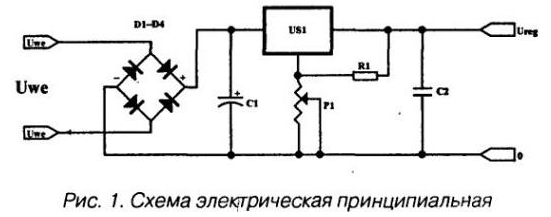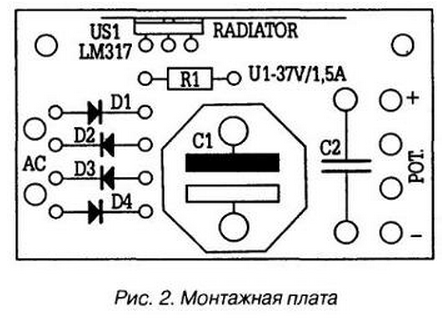Adjustable power supply, 1-37 volts 1,5 amps. Encyclopedia of radio electronics and electrical engineering

Encyclopedia of radio electronics and electrical engineering / Power Supplies
 Comments on the article
Comments on the article
This regulated power supply demonstrates the use of the LM317T integrated circuit. The module-shaped source can be used wherever a voltage in the range of 1 to 37 V and current up to 1,5 A is required.
Using it, you can also design a stationary power source with good parameters. The source structure is simple, and the circuit is tested and reliable - no adjustment and start-up required. Works immediately upon switching on, subject to proper installation. The mains transformer used in the power supply must have a maximum output voltage of 28 V and a current at least equal to the required power supply.

- US1.....LM317;
- R1.....220 kOhm;
- D1-D4.....1N4001;
- P1 ..... 4,7 kOhm;
- C1....1000uF/40V;
- C2 ..... 0,47-1 uF / 63 V


Of the commercially available transformers, TS40/81, TS50/47, TS60/12, TS70/17 meet these requirements. The transformer should be connected to the board with short wires of large diameter. If the powered device or circuit is located quite far from the source, it is recommended to block the power outputs with an additional capacitor of at least 100 nF (preferably ceramic) as close as possible to the powered circuit. The LM317T stabilizer is protected against short circuits, and also has limits on the maximum power dissipation.
It should be equipped with an aluminum radiator with a surface area of at least 1 dm2. The full potential of the LM317T circuit is only achieved by using a mains transformer with a split secondary winding so that it supplies the highest input voltage (e.g. 28V) when the output voltage is above 15V.
The voltage difference must be kept as low as possible (at least 3 V) so that the rated output current can be fully utilized.
Author: Movchan D.A.
 See other articles Section Power Supplies.
See other articles Section Power Supplies.
 Read and write useful comments on this article.
Read and write useful comments on this article.
<< Back
 Latest news of science and technology, new electronics:
Latest news of science and technology, new electronics:
Machine for thinning flowers in gardens
02.05.2024
In modern agriculture, technological progress is developing aimed at increasing the efficiency of plant care processes. The innovative Florix flower thinning machine was presented in Italy, designed to optimize the harvesting stage. This tool is equipped with mobile arms, allowing it to be easily adapted to the needs of the garden. The operator can adjust the speed of the thin wires by controlling them from the tractor cab using a joystick. This approach significantly increases the efficiency of the flower thinning process, providing the possibility of individual adjustment to the specific conditions of the garden, as well as the variety and type of fruit grown in it. After testing the Florix machine for two years on various types of fruit, the results were very encouraging. Farmers such as Filiberto Montanari, who has used a Florix machine for several years, have reported a significant reduction in the time and labor required to thin flowers.
... >>
Advanced Infrared Microscope
02.05.2024
Microscopes play an important role in scientific research, allowing scientists to delve into structures and processes invisible to the eye. However, various microscopy methods have their limitations, and among them was the limitation of resolution when using the infrared range. But the latest achievements of Japanese researchers from the University of Tokyo open up new prospects for studying the microworld. Scientists from the University of Tokyo have unveiled a new microscope that will revolutionize the capabilities of infrared microscopy. This advanced instrument allows you to see the internal structures of living bacteria with amazing clarity on the nanometer scale. Typically, mid-infrared microscopes are limited by low resolution, but the latest development from Japanese researchers overcomes these limitations. According to scientists, the developed microscope allows creating images with a resolution of up to 120 nanometers, which is 30 times higher than the resolution of traditional microscopes. ... >>
Air trap for insects
01.05.2024
Agriculture is one of the key sectors of the economy, and pest control is an integral part of this process. A team of scientists from the Indian Council of Agricultural Research-Central Potato Research Institute (ICAR-CPRI), Shimla, has come up with an innovative solution to this problem - a wind-powered insect air trap. This device addresses the shortcomings of traditional pest control methods by providing real-time insect population data. The trap is powered entirely by wind energy, making it an environmentally friendly solution that requires no power. Its unique design allows monitoring of both harmful and beneficial insects, providing a complete overview of the population in any agricultural area. “By assessing target pests at the right time, we can take necessary measures to control both pests and diseases,” says Kapil ... >>
 Random news from the Archive Random news from the Archive New life for polyurethane waste
04.09.2019
A team from the University of Illinois (USA) has developed a method for breaking down polyurethane, which allows it to be turned into other useful products. The scientists presented the results of their work at the National Meeting of the American Chemical Society.
Polyurethane is a plastic polymer material. It is found in many objects around us: in paints, car parts, furniture padding, home insulation materials. As they fall into disrepair, these items are sent to landfill and incinerated - releasing toxic by-products. The composition of polyurethane includes two components that are difficult to destroy: isocyanates, which are composed of nitrogen, carbon and oxygen; and alcohol groups called polyols.
"Polyols are usually petroleum-based and non-degradable," said graduate student Ephraim Morado, who developed the technology with his supervisor, Steven Zimmerman. To solve this problem, the team included in the polyol a chemical unit that breaks down more easily, acetal. And because polyurethanes are water resistant, the researchers invented an acetal unit that decomposes in water-free solvents.
The scientists added a combination of trichloroacetic acid and dichloromethane to the starting material - as a result, the material swelled and began to decompose rapidly at room temperature. The resulting degradation products can then be redirected to new materials. For example, researchers have been able to turn elastomers - a type of polyurethane used in rubber bands, packaging and car parts - into adhesives.
The authors of the new technology are also testing it on other polyurethane materials. They also plan to experiment with milder solvents such as vinegar to break down the polyurethane.
|
 Other interesting news:
Other interesting news:
▪ Crab and Shrimp Batteries
▪ Workstation 3DBOXX 4170 Xtreme
▪ Optical fiber from food agar
▪ Ultrasound on the spine
▪ A new family of highly integrated real-time clocks
 News feed of science and technology, new electronics
News feed of science and technology, new electronics
 Interesting materials of the Free Technical Library:
Interesting materials of the Free Technical Library:
▪ site section Field strength detectors. Article selection
▪ Article Laconism. Laconic brevity. Popular expression
▪ article How did the stalls in the theaters of the Pushkin era differ from what we are used to? Detailed answer
▪ article Fern. Legends, cultivation, methods of application
▪ Surguchi's article. Simple recipes and tips
▪ article Mains voltage stabilizer with microcontroller control. Encyclopedia of radio electronics and electrical engineering
 Leave your comment on this article:
Leave your comment on this article:
 All languages of this page
All languages of this page
Home page | Library | Articles | Website map | Site Reviews

www.diagram.com.ua
2000-2024







 Arabic
Arabic Bengali
Bengali Chinese
Chinese English
English French
French German
German Hebrew
Hebrew Hindi
Hindi Italian
Italian Japanese
Japanese Korean
Korean Malay
Malay Polish
Polish Portuguese
Portuguese Spanish
Spanish Turkish
Turkish Ukrainian
Ukrainian Vietnamese
Vietnamese



 Leave your comment on this article:
Leave your comment on this article: